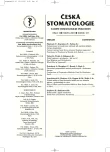Oral Hygiene and Orthodontia: What Kind of Approach?
Ústní hygiena a ortodoncie – jak na to?
Cílem této studie bylo zjistit, do jaké míry zhoršuje nalepení fixního ortodontického aparátu možnosti ústní hygieny pacienta a shrnout jak rizika plynoucí z nedostatečné ústní hygieny a jejich dopad na tvrdé i měkké tkáně ústní dutiny, tak i metody a hygienické pomůcky, které jsou pro ortodontické pacienty prospěšné. U pacientů byla sledována ústní hygiena a krvácení gingivy použitím modifikovaných indexů PBI a API a Ortho – plak indexu. U všech pacientů se po nasazení fixního aparátu objevila vyšší krvácivost gingivy a docházelo k větší kumulaci zubního plaku na ploškách s aparátem. Rovněž některé části aparátu vedly ke zhoršení (mPBI stoupl průměrně o 13, 3 bodu a OPI o 10, 6 %). Po sejmutí aparátu se do 3 měsíců hodnoty mPBI u 17 % pacientů vrátily na úroveň před léčbou, u 61 % bylo nalezeno zlepšení hodnot. U hodnot mAPI byl u 22 % nalezen návrat hodnot na úroveň před léčbou, u 72 % byly nalezeny nižší hodnoty.
Klíčová slova:
ústní hygiena – white spot léze – hyperplastická gingiva – fluoridace
Authors:
R. Tichá; J. Tichý; H. Böhmová
Authors‘ workplace:
Stomatologická klinika LF UK a FN, Plzeň
přednosta doc. MUDr. A. Zicha, CSc.
Published in:
Česká stomatologie / Praktické zubní lékařství, ročník 107, 2007, 3, s. 57-61
Overview
The objective was to determine to what extent the attachment of fixed orthodontic appliance enables oral hygiene in the patient and to summarize possible risks ensuing from insufficient oral hygiene and their impact on hard and soft tissues of oral cavity as well as methods and hygienic agents useful for the patient. The patients were followed up as far as the oral hygiene and gingival bleeding were concerned using modified PBI and API indices, respectively and the Ortho-plaque index. Higher gingival bleeding was associated with attachment of the fixed appliance in all appliance and there was also a higher accumulation of dental plaque on the contact gingival surfaces with the preparation. Likewise, some parts of the appliance resulted in deterioration (mPBI increased by 13.3 points on the average and OPI increased by 10.6%). Three months after the removal of the appliance the mPBI values returned to the level before therapy in 17% of patients, and improvement was observed in 61% of patients. The mAPI values returned to the level before therapy in 22 and in 72% there were lower values.
Key words:
oral hygiene – white spot lesion – hyperplastic gingivitis – fluoridation
Labels
Maxillofacial surgery Orthodontics Dental medicineArticle was published in
Czech Dental Journal

2007 Issue 3
- What Effect Can Be Expected from Limosilactobacillus reuteri in Mucositis and Peri-Implantitis?
- The Importance of Limosilactobacillus reuteri in Administration to Diabetics with Gingivitis
Most read in this issue
- Tooth Pain and Dentine Sensitivity
- A Review on the Characteristics and Indications of Mineral Trioxide Aggregate (MTA) for its Use in Endodontics
- Effect of Plain and Fluoridated Milk on Root Surface Caries in Vitro
- Overdenture –Teeth or Implants Evaluation
